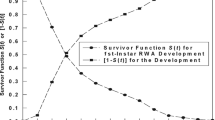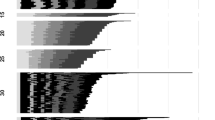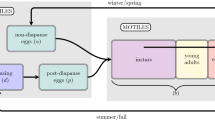Abstract
Control interventions in sustainable pest management schemes are set according to the phenology and the population abundance of the pests. This information can be obtained using suitable mathematical models that describe the population dynamics based on individual life history responses to environmental conditions and resource availability. These responses are described by development, fecundity and survival rate functions, which can be estimated from laboratory experiments. If experimental data are not available, data on field population dynamics can be used for their estimation. This is the case of the extrinsic mortality term that appears in the mortality rate function due to biotic factors. We propose a Bayesian approach to estimate the probability density functions of the parameters in the extrinsic mortality rate function, starting from data on population abundance. The method investigates the time variability in the mortality parameters by comparing simulated and observed trajectories. The grape berry moth, a pest of great importance in European vineyards, has been considered as a case study. Simulated data have been considered to evaluate the convergence of the algorithm, while field data have been used to obtain estimates of the mortality for the grape berry moth.






Similar content being viewed by others
References
Baumgärtner J, Baronio P (1988) Modello fenologico di volo di Lobesia botrana Den. et Schiff. (Lep. Tortricidae) relativo alla situazione ambientale della Emilia-Romagna. Bollettino dell’Istituto di Entomologia. ‘Guido Grandi’ Dell’Università di Bologna 43:157–170
Bieri M, Baumgärtner J, Bianchi G, Delucchi V, Von Arx R (1983) Development and fecundity of pea aphid (Acyrthosiphon pisum Harris) as affected by constant temperatures and by pea varieties. Mitt Schweiz Entomol Ges 56:163–171
Briolini G, Di Cola G, Gilioli G (1997) Stochastic model for population development of L. botrana (Den. et Schiff.). IOBC/WPRS Bull 21:79–81
Buffoni G, Pasquali S (2007) Structured population dynamics: continuous size and discontinuous stage structures. J Math Biol 54(4):555–595
CABI Invasive Species Compendium (2014) Lobesia botrana (grape berry moth). www.cabi.org/isc/datasheet/42794. Accessed 14 July 2016
Di Cola G, Gilioli G, Baumgärtner J (1999) Mathematical models for age-structured population dynamics. In: Huffaker CB, Gutierrez AP (eds) Ecological entomology. Wiley, New York, pp 503–534
Dorazio RM (2016) Bayesian data analysis in population ecology: motivations, methods, and benefits. Popul Ecol 58:3144
Duane S, Kennedy AD, Pendleton BJ, Roweth D (1987) Hybrid monte carlo. Phys Lett B 195(2):216–222
Durham GB, Gallant AR (2002) Numerical techniques for maximum likelihood estimation of continuous-time diffusion processes. J Bus Econ Stat 20:297–338
EFSA Scientific Commettee (2011) Statistical significance and biological relevance. EFSA J 9(9):2372
Elerian O, Chib S, Shephard N (2001) Likelihood inference for discretely observed nonlinear diffusions. Econometrica 69:959–993
Gardiner CW (1994) Handbook of stochastic methods. Springer, Berlin
Gilioli G, Pasquali S, Marchesini E (2016) A modelling framework for pest population dynamics and management: an application to the grape berry moth. Ecol Model 320:348–357
Gilioli G, Pasquali S, Ruggeri F (2008) Bayesian inference for functional response in a stochastic predator–prey system. Bull Math Biol 70:358–381
Gilioli G, Pasquali S, Ruggeri F (2012) Nonlinear functional response parameter estimation in a stochastic predator–prey model. Math Biosci Eng 9(1):75–96
Gillespie CS, Golightly A (2010) Bayesian inference for generalized stochastic population growth models with applications to aphids. J R Stat Soc 59(2):341–357
Golightly A, Wilkinson D (2005) Bayesian inference for stochastic kinetic models using a diffusion approximation. Biometrics 61:781–788
Golightly A, Wilkinson D (2008) Bayesian inference for nonlinear multivariate diffusion models observed with error. Comput Stat Data Anal 52:1674–1693
Gutierrez AP, Ponti L, Cooper ML, Gilioli G, Baumgärtner J (2012) Prospective analysis of the invasive potential of the European grapevine moth L. Botrana (De. & Schiff.) in California. Agric For Entomol 14:225–238
Heydari J, Lawless C, Lydall DA, Wilkinson DJ (2014) Fast Bayesian parameter estimation for stochastic logistic growth models. Biosystems 122:55–72
Hooten MB, Wikle CK (2008) A hierarchical Bayesian non-linear spatio-temporal model for the spread of invasive species with application to the Eurasian collared-dove. Environ Ecol Stat 15:59–70
Huffaker CB, Gutierrez AP (eds) (1999) Ecological entomology. Wiley, New York
Lactin DJ, Holliday NJ, Johnson DL, Craigen R (1995) Improved rate model of temperature-dependent development by arthropods. Environ Entomol 24:68–75
Lamonica D, Herbach U, Orias F, Clément B, Charles S, Lopes C (2016a) Mechanisitc modelling of daphnid–algae dynamics within a laboratory microcosm. Ecol Model 320:213–230
Lamonica D, Clément B, Charles S, Lopes C (2016b) Modelling algae–duckweed interaction under chemical pressure within a laboratory microcosm. Ecotoxicol Environ Saf 128:252–265
Lanzarone E, Pasquali S, Mussi V, Ruggeri F (2014) Bayesian estimation of thermal conductivity and temperature profile in a homogeneous mass. Numer Heat Transf Part B Fundam 66(5):397–421
Marchesini E (2007) I limitatori naturali della tignoletta nell’agroecosistema vigneto. In: Anfora G et al (eds) Le tignole della vite. Agricoltura Integrata, Istituto Agrario di San Michele all’Adige, pp 40–55
Marchesini E, Dalla Montà L (2004) Nel Veneto quattro generazioni di tignoletta della vite. Inf Agrar 60(4):75–78
Martín-Fernández L, Gilioli G, Lanzarone E, Míguez J, Pasquali S, Ruggeri F, Ruiz DP (2014) A Rao–Blackwellized particle filter for joint parameter estimation and biomass tracking in a stochastic predator–prey system. Math Biosci Eng 11(3):573–597
Martín-Fernández L, Lanzarone E (2015) A particle-filtering approach for real-time estimation of thermal conductivity and temperature tracking in homogeneous masses. Numer Heat Transf Part B Fundam 67(6):507–530
McDonald L, Manly B, Lockwood J, Logan JA (eds) (1989) Estimation and analysis of insect populations. Springer, Berlin
Metz JAJ, Diekmann O (eds) (1986) The dynamics of physiologically structured populations. Springer, Berlin
Pavan F, Floreani C, Barro P, Zandigiacomo P, Dalla Montà L (2010) Influence of generation and photoperiod on larval development of L. Botrana (Lepidoptera: Tortricidae). Environ Entomol 39(5):1652–1658
Plummer M (2003) JAGS: a program for analysis of Bayesian graphical models using Gibbs sampling. In: Hornik K, Leisch F, Zeileis A (eds) Proceedings of the 3rd international workshop on distributed statistical computing (DSC 2003). Technische Universität Wien, Vienna, pp 20–22
Plummer M, Best N, Cowles K, Vines K (2006) CODA: convergence diagnosis and output analysis for MCMC. R News 6:711
Prakasa Rao BLS (2000) Bayes estimation for some stochastic partial differential equations. J Stat Plan Inference 91(2):511–524
Roques L, Walker E, Franck P, Soubeyrand S, Klein EK (2016) Using genetic data to estimate diffusion rates in heterogeneous landscape. J Math Biol. doi:10.1007/s00285-015-0954-4
Stan Development Team (2015) Stan modeling language users guide and reference manual (version 2.9.0) http://mc-stan.org
Spence MA, Blackwell PG, Blanchard JL (2016) Parameter uncertainty of a dynamic multispecies size spectrum model. Can J Fish Aquat Sci 73(4):589–597
Tsehaye I, Jones ML, Bence JR, Brenden TO, Madenjian CP, Warner DM (2014) A multispecies statistical age-structured model to assess predator–prey balance: application to an intensively managed Lake Michigan pelagic fish community. Can J Fish Aquat Sci 71(4):627–644
Xun X, Cao J, Mallick B, Maity A, Carroll RJ (2013) Parameter estimation of partial differential equation models. J Am Stat Assoc 108(503):1009–1020
Acknowledgements
The research leading to these results was partially funded by the European Union’s Seventh Framework Programme managed by REA-Research Executive Agency http://ec.europa.eu/research/rea([FP7/2007-2013][FP7/2007-2011]) under Grant agreement No. [262059]. The authors are grateful to two anonymous referees for their useful suggestions, which allowed to improve the paper.
Author information
Authors and Affiliations
Corresponding author
Rights and permissions
About this article
Cite this article
Lanzarone, E., Pasquali, S., Gilioli, G. et al. A Bayesian estimation approach for the mortality in a stage-structured demographic model. J. Math. Biol. 75, 759–779 (2017). https://doi.org/10.1007/s00285-017-1099-4
Received:
Revised:
Published:
Issue Date:
DOI: https://doi.org/10.1007/s00285-017-1099-4




